fuel consumption Peugeot 508 RXH 2013 Owner's Manual
[x] Cancel search | Manufacturer: PEUGEOT, Model Year: 2013, Model line: 508 RXH, Model: Peugeot 508 RXH 2013Pages: 308, PDF Size: 8.95 MB
Page 4 of 308

.
.
Contents
Instrument panel 49
Indicator and warning lamps 50
Gauges and indicators 61
Tr ip computer 66
Setting the date and time 69
Instruments and controlsFamiliarisation
Remote control key 70
Alarm 80
Electric windows 82
Boot 84
Motorised tailgate 85
Panoramic sunroof 88
Fuel tank 89
Diesel misfuel prevention 90
Access
Front seats 92
Rear seats 96
Mirrors 98
Steering wheel adjustment 100
Interior fi ttings 101
Boot fi ttings 104
Heating and Ventilation 110
Dual-zone digital air conditioning 112
Quad-zone digital air conditioning 115
Rear screen demist - defrost 120
Programmable Heating / Ventilation 121
Comfort
Electric parking brake 123
6-speed electronic gearbox 130
Hill star t assist 134
Head-up display 135
Speed limiter 138
Cruise control 140
Parking sensors 142
Parking space sensors 144
Driving
Lighting controls 146
LED lamps 149
Automatic illumination of headlamps 151
Headlamp adjustment 154
Directional lighting 155
Wiper controls 156
Automatic rain sensitive wipers 158
Cour tesy lamps 160
Interior mood lighting 161
Visibility Hybrid system
Presentation 22
Starting / switching off 25
Ready lamp 29
HYbrid4 mode selector 29
Energy consumption / generation
indicator 32
Display of hybrid power fl ow 33
HYbrid4 frequently asked questions 36
Eco off 39
Eco-driving 40
Consumption 42
High voltage battery 43
Car washing machine or tunnel 47
Vehicle recovery 48
Page 7 of 308
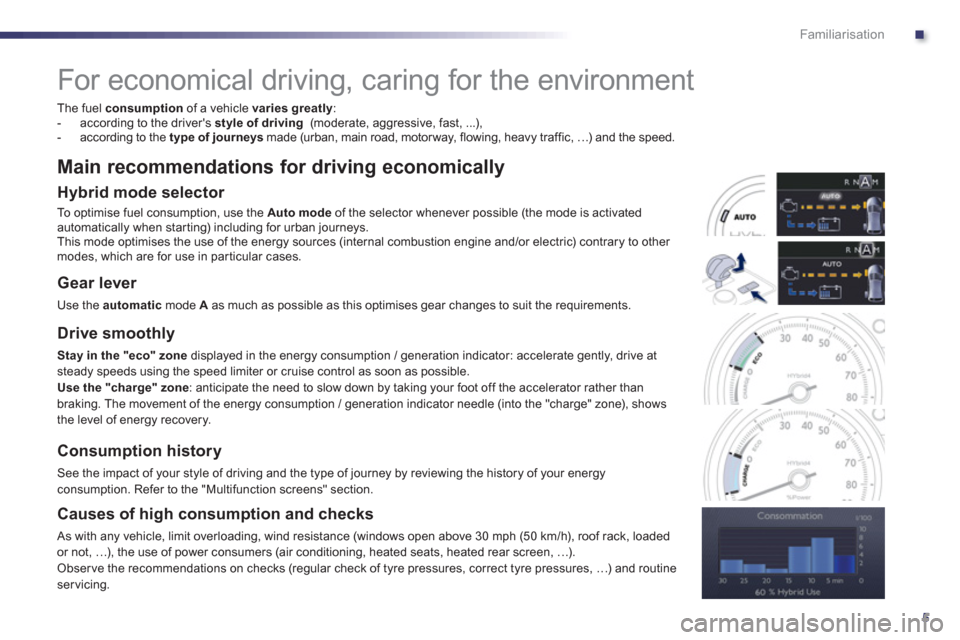
.
5
Familiarisation
For economical driving, caring for the environment
The fuel consumptionof a vehicle varies greatly:
- according to the driver's style of driving
(moderate, aggressive, fast, ...),
- according to the type of journeys
made (urban, main road, motorway, flowing, heavy traffic, …) and the speed.
Main recommendations for driving economically
Hybrid mode selector
To optimise fuel consumption, use the Automodeof the selector whenever possible (the mode is activated
automatically when starting) including for urban journeys.
This mode optimises the use of the energy sources (internal combustion engine and/or electric) contrary to other modes, which are for use in par ticular cases.
Gear lever
Use the automatic
mode A
as much as possible as this optimises gear changes to suit the requirements.
Drive smoothly
Stay in the "eco" zone
displayed in the energy consumption / generation indicator: accelerate gently, drive atsteady speeds using the speed limiter or cruise control as soon as possible. Use the "charge" zone: anticipate the need to slow down by taking your foot off the accelerator rather than
braking. The movement of the energy consumption / generation indicator needle (into the "charge" zone), shows
the level of energy recovery.
Consumption history
See the impact of your style of driving and the type of journey by reviewing the history of your energyconsumption. Refer to the "Multifunction screens" section.
Causes of high consumption and checks
As with any vehicle, limit overloading, wind resistance (windows open above 30 mph (50 km/h), roof rack, loaded
or not, …), the use of power consumers (air conditioning, heated seats, heated rear screen, …).
Obser ve the recommendations on checks (regular check of tyre pressures, correct tyre pressures, …) and routine servicing.
Page 26 of 308
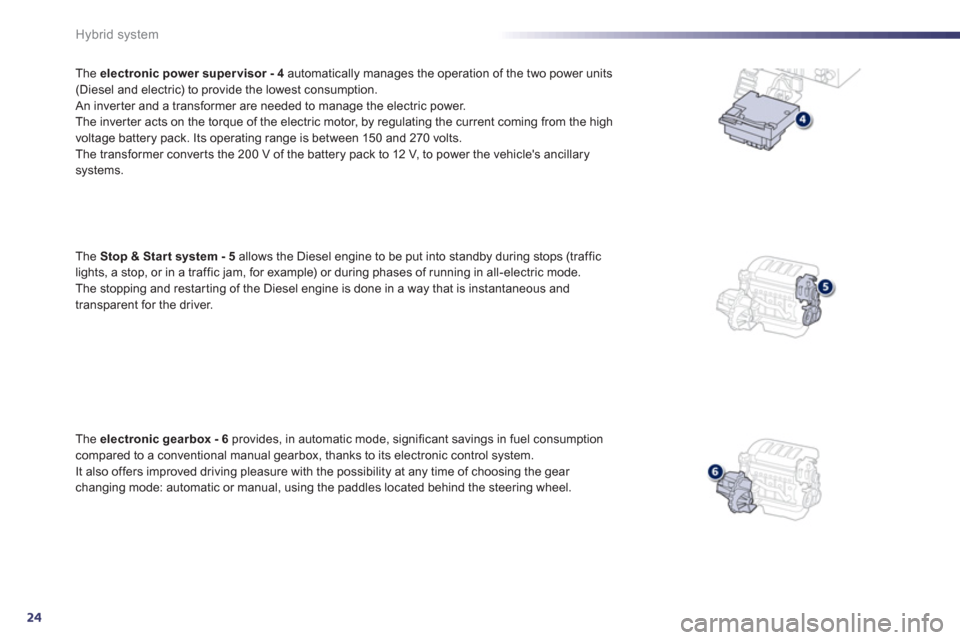
24
Hybrid system
The electronic power super visor - 4automatically manages the operation of the two power units(Diesel and electric) to provide the lowest consumption.
An inver ter and a transformer are needed to manage the electric power.
The inver ter acts on the torque of the electric motor, by regulating the current coming from the high
voltage battery pack. Its operating range is between 150 and 270 volts.
The trans
former conver ts the 200 V of the battery pack to 12 V, to power the vehicle's ancillary
systems.
Th
e Stop & Star t system - 5
allows the Diesel engine to be put into standby during stops (traffic
lights, a stop, or in a traffic jam, for example) or during phases of running in all-electric mode.
The stopping and restar ting of the Diesel engine is done in a way that is instantaneous and
transparent for the driver.
Th
e electronic gearbox - 6provides, in automatic mode, significant savings in fuel consumption compared to a conventional manual gearbox, thanks to its electronic control system.
It also offers improved driving pleasure with the possibility at any time of choosing the gear changing mode: automatic or manual, using the paddles located behind the steering wheel.
Page 31 of 308
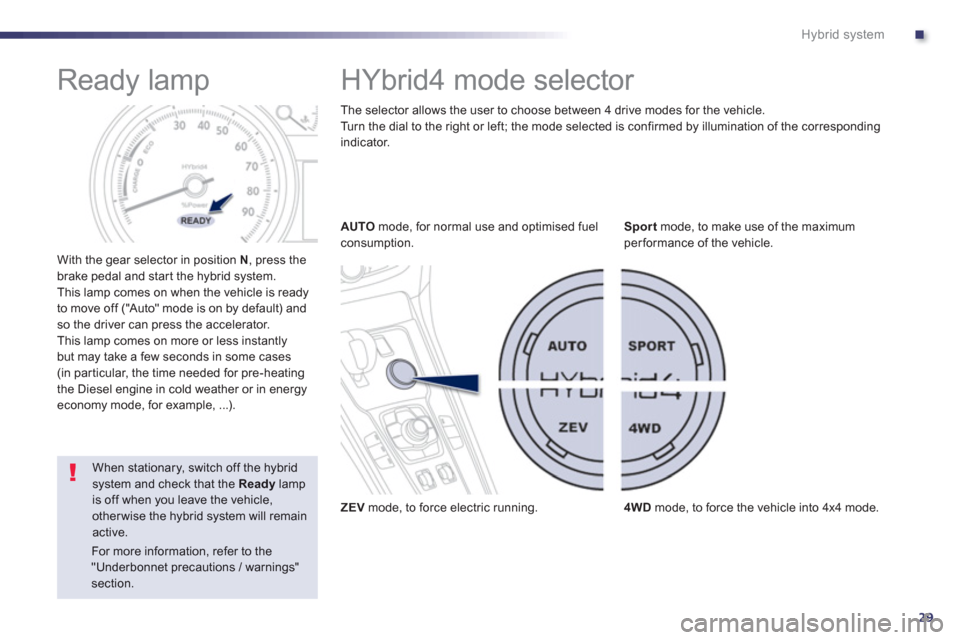
.
29
Hybrid system
Ready lamp
With the gear selector in position N, press the
brake pedal and star t the hybrid system.
This lamp comes on when the vehicle is read
y
to move off ("Auto" mode is on by default) andso the driver can press the accelerator.
This lamp comes on more or less instantlybut may take a few seconds in some cases (in par ticular, the time needed for pre-heating
the Diesel engine in cold weather or in energy economy mode, for example, ...).
HYbrid4 mode selector
AUTOmode, for normal use and optimised fuelconsumption.
ZEVmode, to force electric running.S
portmode, to make use of the maximum
performance of the vehicle.
4WDmode, to force the vehicle into 4x4 mode.
When stationary, switch off the hybridsystem and check that the Readylamp is off when you leave the vehicle,otherwise the hybrid system will remainactive. Th
e selector allows the user to choose between 4 drive modes for the vehicle.
Turn the dial to the right or left; the mode selected is confirmed by illumination of the corresponding indicator.
For more information, refer to the "Underbonnet precautions / warnings" section.
Page 32 of 308
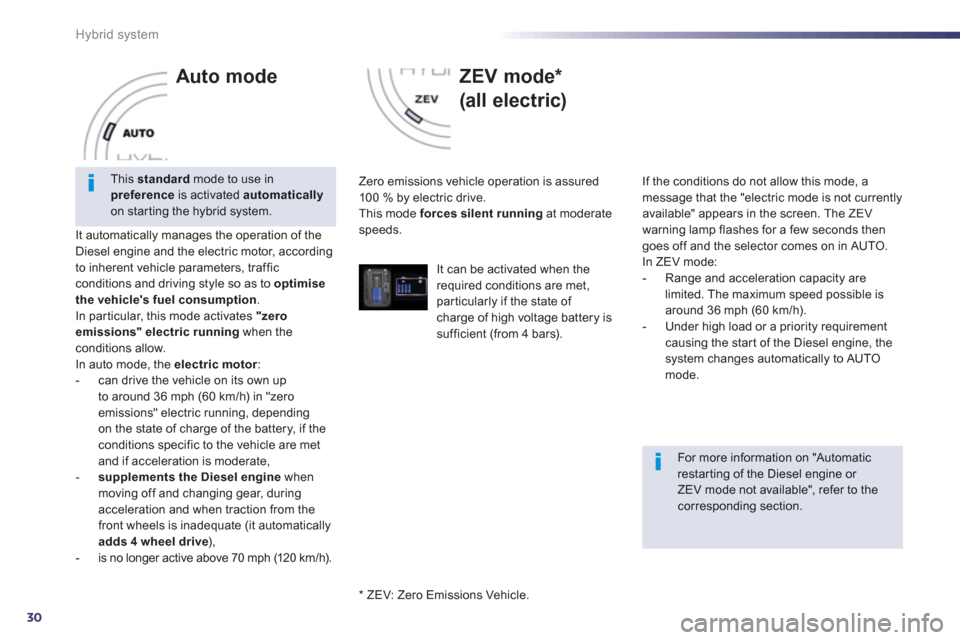
30
Hybrid system
Auto mode
It automatically manages the operation of the
Diesel engine and the electric motor, according
to inherent vehicle parameters, traffic
conditions and driving style so as to optimise
the vehicle's fuel consumption.In par ticular, this mode activates "zero emissions" electric runningwhen theconditions allow.
In auto mode, the electric motor
:
- can drive the vehicle on its own up
to around 36 mph
(60 km/h) in "zero
emissions" electric running, dependingon the state of charge of the battery, if the conditions specific to the vehicle are metand if acceleration is moderate, -supplements the Diesel enginewhen moving off and changing gear, during acceleration and when traction from thefront wheels is inadequate (it automaticallyadds4 wheel drive ),
- is no longer active above 70 mph (120 km / h).
ZEV mode *
(all electric)
Zero emissions vehicle operation is assured
10 0 % by electric drive.
This mode forces silent runningat moderatespeeds.
If the conditions do not allow this mode
, amessage that the "electric mode is not currentlyavailable" appears in the screen. The ZEV
warning lamp flashes for a few seconds then
goes off and the selector comes on in AUTO.
In ZEV mode:
- Range and acceleration capacity are
limited. The maximum speed possible is
around 36 mph (60 km/h).
- Under high load or a priority requirement causing the star t of the Diesel engine, thesystem changes automatically to AUTO mode.
This standard
mode to use inpreferenceis activated automaticallyon star ting the hybrid system.
For more information on "Automaticrestarting of the Diesel engine or ZEV mode not available", refer to the corresponding section.
*
ZEV: Z
ero Emissions Vehicle.
It can be activated when therequired conditions are met, particularly if the state of charge of high voltage battery is sufficient (from 4 bars).
Page 37 of 308
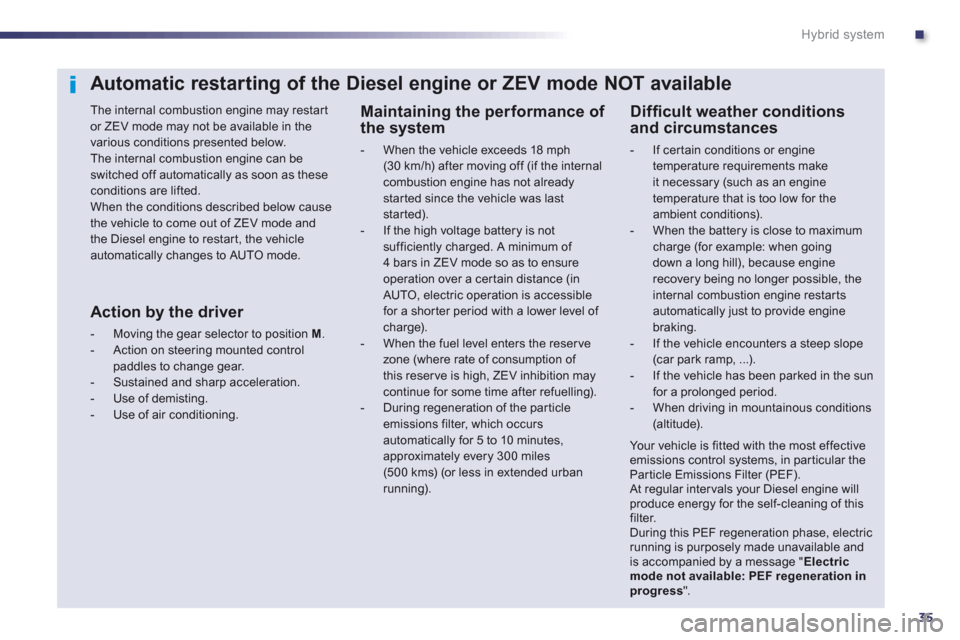
.
35
Hybrid system
Automatic restarting of the Diesel engine or ZEV mode NOT available
The internal combustion engine may restar t or ZEV mode may not be available in the various conditions presented below.
The internal combustion engine can be switched off automatically as soon as these conditions are lifted. When the conditions described below causethe vehicle to come out of ZEV mode and the Diesel engine to restar t, the vehicleautomatically changes to AUTO mode.
Diffi cult weather conditions and circumstances
- If certain conditions or engine
temperature requirements make it necessary (such as an enginetemperature that is too low for the ambient conditions). - When the battery is close to maximum charge (for example: when goingdown a long hill), because enginerecovery being no longer possible, theinternal combustion engine restarts automatically just to provide engine braking.- If the vehicle encounters a steep slope (car park ramp, ...).- If the vehicle has been parked in the sun for a prolonged period.- When driving in mountainous conditions (altitude).
Your vehicle is fitted with the most effectiveemissions control systems, in par ticular theParticle Emissions Filter (PEF). At regular intervals your Diesel engine will produce energy for the self-cleaning of this filter.During this PEF regeneration phase, electric running is purposely made unavailable andis accompanied by a message "Electricmode not available: PEF regeneration inprogress
".
Maintaining the performance of the system
- When the vehicle exceeds 18 mph
(30 km/h) after moving off (if the internal combustion engine has not alreadystarted since the vehicle was last started). - If the high voltage battery is notsufficiently charged. A minimum of 4 bars in ZEV mode so as to ensure operation over a cer tain distance (in AUTO, electric operation is accessiblefor a shorter period with a lower level of charge).- When the fuel level enters the reserve zone (where rate of consumption of this reserve is high, ZEV inhibition maycontinue for some time after refuelling).- During regeneration of the par ticle emissions filter, which occurs
automatically for 5 to 10 minutes, approximately every 300 miles(500 kms) (or less in extended urban running).
Action by the driver
- Moving the gear selector to position M.
- Action on steering mounted controlpaddles to change gear.
- Sustained and sharp acceleration.
- Use of demisting.
- Use of air conditioning.
Page 39 of 308
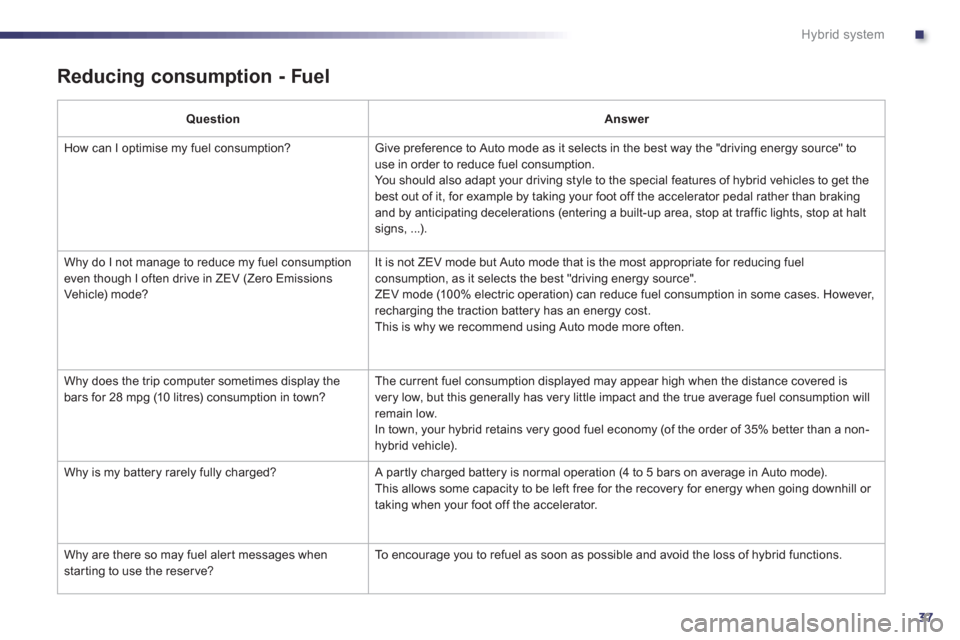
.
37
Hybrid system
Reducing consumption - Fuel
QuestionAnswer
How can I optimise m
y fuel consumption? Give preference to Auto mode as it selects in the best way the "driving energy source" to
use in order to reduce fuel consumption.
You should also adapt your driving style to the special features of hybrid vehicles to get the
best out of it, for example by taking your foot off the accelerator pedal rather than braking and by anticipating decelerations (entering a built-up area, stop at traffic lights, stop at halt
signs, ...).
Wh
y do I not manage to reduce my fuel consumptioneven though I often drive in ZEV (Zero EmissionsVehicle) mode? It is not ZEV mode but Auto mode that is the most appropriate for reducin
g fuelconsumption, as it selects the best "driving energy source".
ZEV mode (10 0% electric operation) can reduce fuel consumption in some cases. However,recharging the traction battery has an energy cost.
This is why we recommend using Auto mode more often.
Wh
y does the trip computer sometimes display the
bars for 28 mpg (10 litres) consumption in town?The current fuel consumption displayed may appear high when the distance covered is
very low, but this generally has very little impact and the true average fuel consumption willremain low.
In town, your hybrid retains very good fuel economy (of the order of 35% better than a non-hybrid vehicle).
Wh
y is my battery rarely fully charged? A par tly charged battery is normal operation (4 to 5 bars on average in Auto mode).
This allows some capacity to be left free for the recovery for energy when going downhill or
taking when your foot off the accelerator.
Wh
y are there so may fuel aler t messages whenstarting to use the reser ve?To e n c o u r age you to refuel as soon as possible and avoid the loss of hybrid functions.
Page 42 of 308
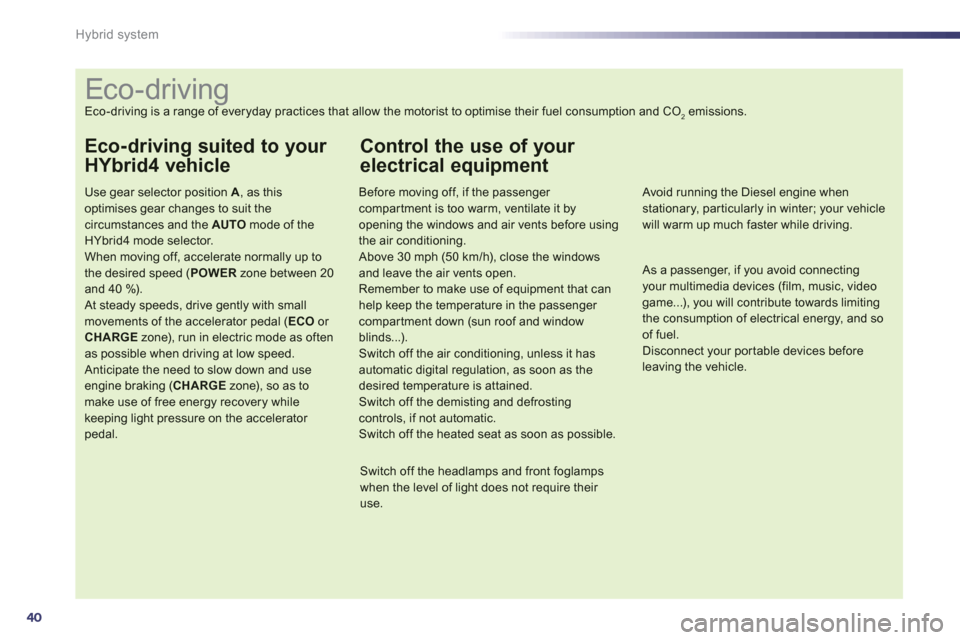
40
Hybrid system
Eco-driving
Eco-driving is a range of everyday practices that allow the motorist to optimise their fuel consumption and CO2emissions.
Eco-driving suited to your
HYbrid4 vehicle
Use gear selector position A , as thisoptimises gear changes to suit the
circumstances and the AUTOmode of theHYbrid4 mode selector. When moving off, accelerate normally up tothe desired speed (POWER
zone between 20and 40 %).
At steady speeds, drive gently with smallmovements of the accelerator pedal (ECO
or CHARGEzone), run in electric mode as oftenas possible when driving at low speed. Anticipate the need to slow down and use engine braking ( CHARGE
zone), so as to make use of free energy recovery while keeping light pressure on the accelerator pedal.
Control the use of your
electrical equipment
Before moving off, if the passenger compartment is too warm, ventilate it byopening the windows and air vents before using the air conditioning.
Above 30 mph (50 km/h), close the windows and leave the air vents open.
Remember to make use of equipment that canhelp keep the temperature in the passenger compartment down (sun roof and windowblinds...). Switch off the air conditioning, unless it has automatic digital regulation, as soon as thedesired temperature is attained. Switch off the demisting and defrostingcontrols, if not automatic.
Switch off the heated seat as soon as possible.
Switch off the headlamps and front foglampswhen the level of light does not require their use.
Avoid running the Diesel engine when stationary, par ticularly in winter; your vehicle will warm up much faster while driving.
As a passenger, if you avoid connecting your multimedia devices (film, music, videogame...), you will contribute towards limitingthe consumption of electrical energy, and soof fuel.
Disconnect your por table devices beforeleaving the vehicle.
Page 43 of 308
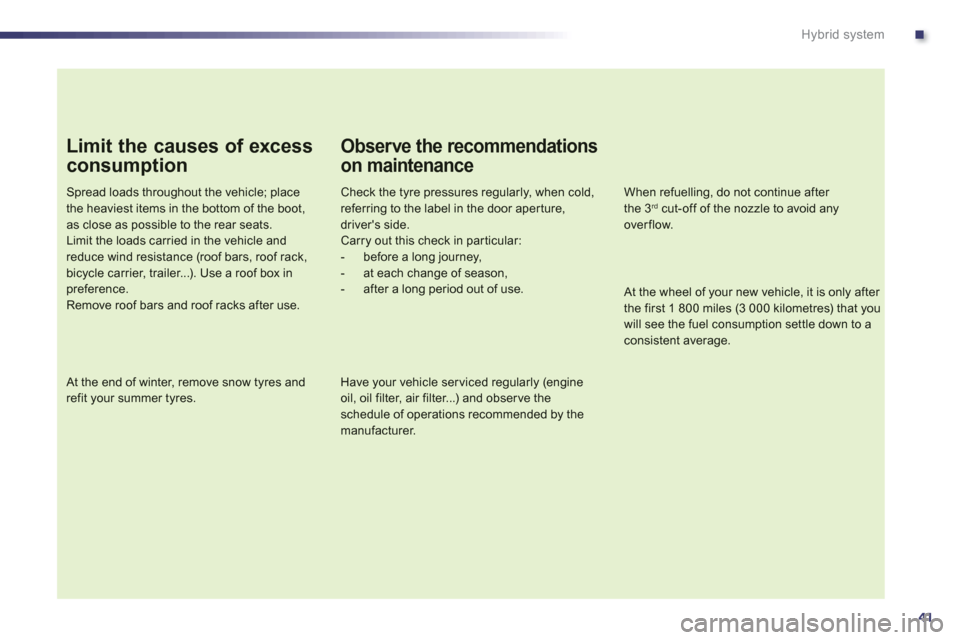
.
41
Hybrid system
Limit the causes of excess
consumption
Spread loads throughout the vehicle; placethe heaviest items in the bottom of the boot,
as close as possible to the rear seats.Limit the loads carried in the vehicle and reduce wind resistance (roof bars, roof rack, bicycle carrier, trailer...). Use a roof box inpreference.Remove roof bars and roof racks after use.
At the end of winter, remove snow tyres and refit your summer tyres.
Observe the recommendations
on maintenance
Check the tyre pressures regularly, when cold, referring to the label in the door aper ture, driver's side.Carry out this check in par ticular:- before a long journey,- at each change of season,- after a long period out of use.
When refuelling, do not continue after the 3rdcut-off of the nozzle to avoid any overflow.
Have your vehicle ser viced regularly (engine oil, oil filter, air filter...) and obser ve the schedule of operations recommended by the
manufacturer.
At the wheel of your new vehicle, it is only after the first 1 800 miles (3 000 kilometres) that youwill see the fuel consumption settle down to aconsistent average.
Page 51 of 308
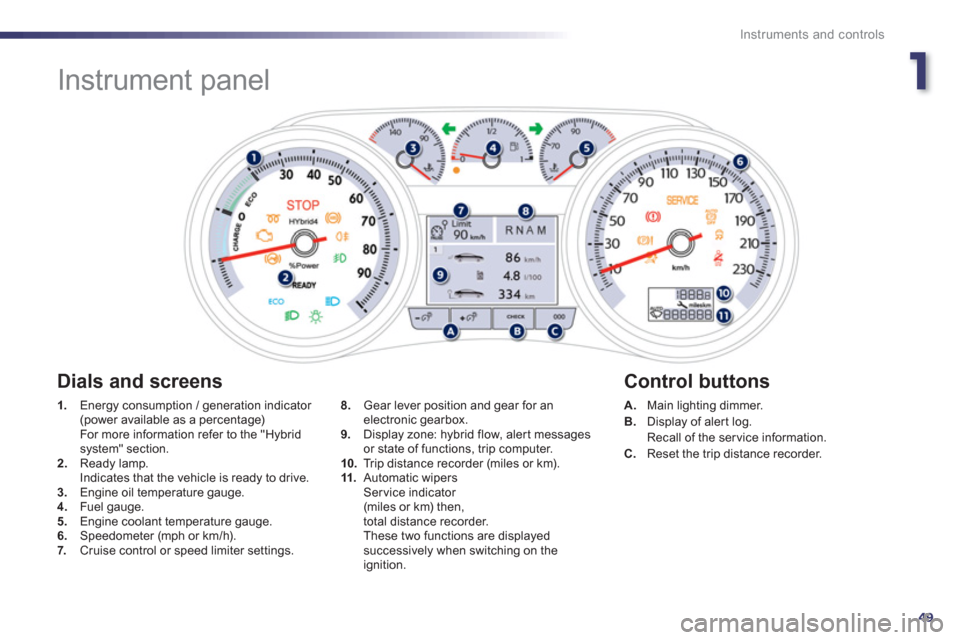
1
49
Instruments and controls
Instrument panel
1.
Energy consumption / generation indicator (power available as a percentage) For more information refer to the "Hybrid system" section. 2.Ready lamp.
Indicates that the vehicle is ready to drive. 3.Engine oil temperature gauge. 4. Fuel gauge.
5. Engine coolant temperature gauge.
6.Speedometer (mph or km/h).7. Cruise control or speed limiter settings.
A.Main lighting dimmer. B.
Display of aler t log.
Recall of the service information.
C. Reset the trip distance recorder.
8.
Gear lever position and gear for anelectronic gearbox.
9. Display zone: hybrid flow, alert messages
or state of functions, trip computer.
10.Trip distance recorder (miles or km). 11.Automatic wipersSer vice indicator (miles or km) then,
total distance recorder.
These two functions are displayedsuccessively when switching on the ignition.
Dials and screens
Control buttons